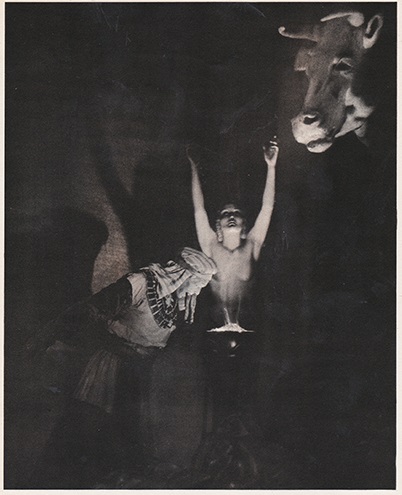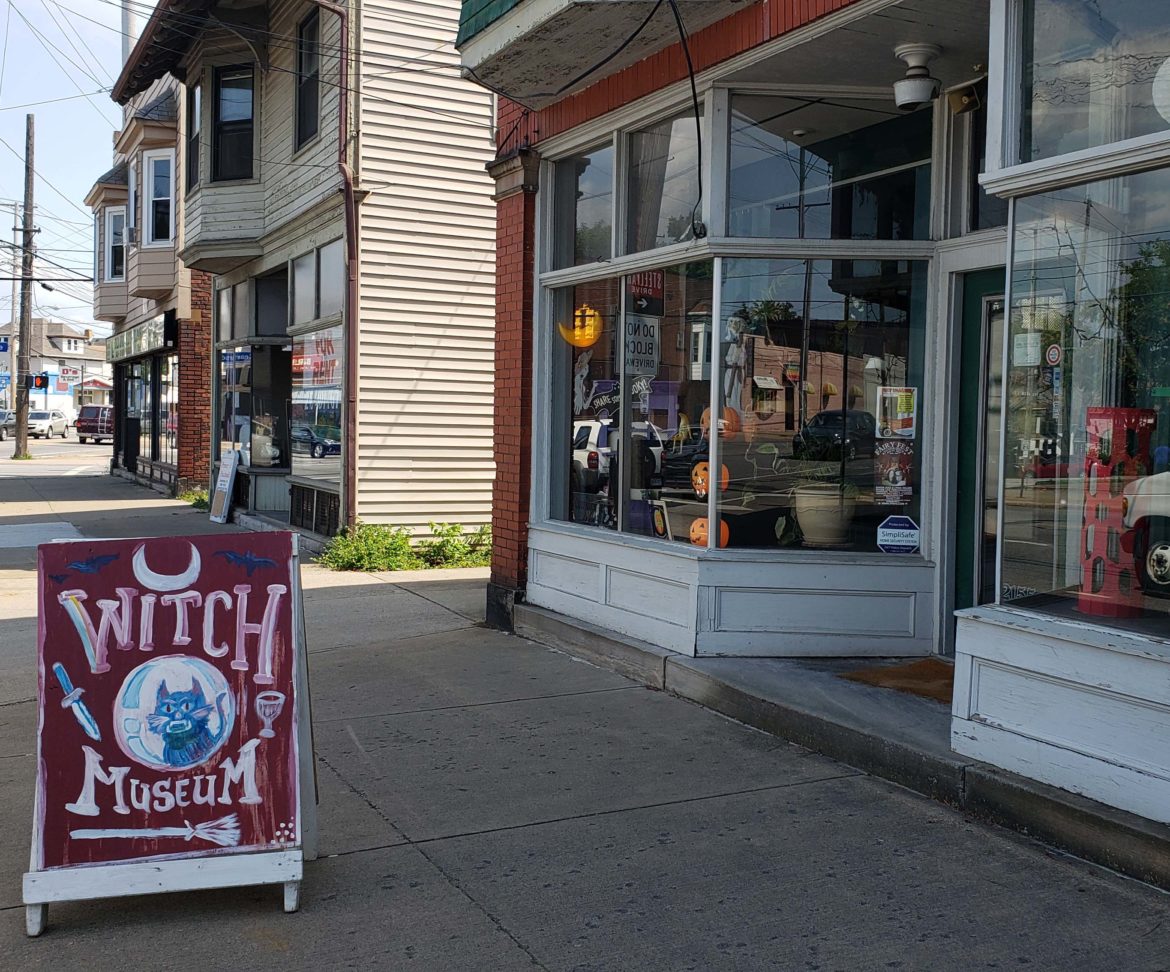
CLEVELAND – Raymond Buckland’s Museum of Witchcraft and Magick opened a new exhibition on August 3, 2019 titled “WITCHES: An exhibition of the photographs by William Mortensen.” The exhibition is in collaboration with the Stephen Romano Gallery.
The exhibition features previously unseen works by Mortensen, an American glamour photographer known for his portraits of Hollywood icons from the 1920s through the 1940’s.
Mortensen exploited the Pictorialist style, a movement that is iconic of the turn of the 19th Century, and became the last great photographer of the movement. Pictoralism involves images derived from photographs that were enhanced by other means, such as adding pen or brush strokes. They are often in soft light and lack sharp focus. The technique emerged at a time when artists and critics were unsure of the role of photography in art. It was ultimately replaced with the sharp contrasts and crisp focus of modernism but not before cementing both a style and movement that is distinctive of early Twentieth Century photography.

“The preparation for the Sabbot has been a favorite and frequent theme of the artists who have dealt with this material. The young witch, eager and exuberant, is being rubbed by the old witch with a magic ointment. By the virtue of this salve, according to tradition, the witches were enabled to fly to their assemblies.” – William Mortensen 1935. Image courtesy of Stephen Romano Gallery
Mortensen produced calculated retouched romantic images, an approach that would leave his critics questing the worth of this art. One such challenge was a prolonged and public debate with American realist photographer, Ansel Adams, who referred to Mortensen as “the anti-Christ.”
Mortensen’s work has recently experienced a revival. Pushed into relative obscurity by the rise and dominance of realism, his art vanished from the public eye though readily recognizable by aficionados. Those enthusiasts kept Mortensen’s vision alive, one that combined photographic realism with artistic enhancements to create an image that mixes painting and photography, much like apps on smartphones today modify photos.
Mortensen would go on to work with the famous director Cecil B. DeMille and become a costumer, set decorator, and photographer to several of his films. DeMille would become an admirer and patron of Mortensen’s artwork. Mortensen would continue work until 1929 when an affair with actress Fay Wray would be revealed and ultimately drive him from Hollywood.
It was through his Hollywood connection that Mortensen would acquire a fascination with the occult, and his favorite subject was witches. His muse would be the early horror films of the 1920’s. He was drawn to the grotesque and fantastic; his work, in many ways, anticipated the rise of magical realism.
The exhibition at Buckland’s Museum of Witchcraft and Magick picks up the story of Mortensen’s captivation with witches.

“ISIS” caption on verso reads “With the first dawning of written record, the cow represented the fecundity of Nature. In the age-old temples of Egypt, Isis, the moon-goddess, was worshipped in the form of a woman with a cow’s head. Decapitated by her son, Horus, the sun-god, she received from Thoth a cow’s head as a substitute. It is not unlikely that the thread of a race memory linking the moon and cows persists in the children’s rhyme of the cow jumping over the moon”. Image courtesy of Stephen Romano Gallery
Steve Intermill, Director of Buckland’s Museum of Witchcraft and Magick, explains that the “Mortensen photos depict a supernatural world rarely seen, where witches not only exist in the shadow but radiate within the light. His genius techniques enhance reality, bringing to focus the liminal space that esoteric imagery needs for success.”
The exhibition will primarily feature unseen work by Mortensen. The photographs range from the seductive to the savage, exposing Mortensen’s obsessions with the intersection of magick, sexuality, and the grotesque.
Mortensen himself would write in 1936 in San Francisco: Camera Craft in a commentary to the image titled “Preparation for the Sabbat” that “A very fruitful field for grotesque art is afforded by the manifestations of witchcraft and demonology. Fear, secrecy, and converse with evil powers, were characteristic elements of this mysterious cult which is as old as man. These elements are of the very substance of the grotesque … but little has been done with it by photographers.”
The Raymond Buckland’s Museum of Witchcraft and Magick recently celebrated its re-opening in the Old Brooklyn neighborhood of Cleveland between Cleveland Metroparks Zoo and Brooklyn Heights Cemetery on Broadview Road. Intermill told Cleveland.com that the new location is “four times as big, we’ve been able to bring out so much more of our collection from storage.”
Founded by luminary author, the late Raymond Buckland, a Wiccan priest and elder as well as comedian and advocate for Witchcraft, the Museum was founded in 1966 using Buckland’s personal collection of Witchcraft memorabilia collected over his lifetime. The Museum has had homes in New York City and New Orleans before finding its current home in Cleveland where it opened in 2015 and recently relocated to the Brooklyn neighborhood.

The Buckland Museum of Witchcraft and Magick. [Courtesy S. Intermill]
The Museum contains one of the most impressive and important collections on Witchcraft in the United States. Among the artifacts housed in the Museum are the horned pipe and briefcase of Gerald Gardner; Buckland’s “cards of alchemy”; a headdress made by the late Morning Glory Zell, Buckland’s ceremonial robe; the Horned God helmet; Buckland’s ritual wand and besom; Aleister Crowley’s Scorpion ceremonial bowls and Trident Wand, as well as an extensive collection of athames, chalices and books.
Intermill says that “It’s just exciting to show something of such beauty and depth, and of real significance to our culture.” He hopes the Museum is a resource to learn “the history of witchcraft and demystifying it, [so] people learn a little more about their neighbors.”
“WITCHES: An exhibition of the photographs by William Mortensen” runs now through November 3, 2019. The exhibition also features an online curated catalog with text by renowned Swedish occult writer and mage, Idlu Lili Regulus, author of ‘Hekate the Crossroads.’
The Buckland Museum of Witchcraft and Magick is located at 2155 Broadview Road, Cleveland. It is open 12 Noon to 7PM, Tuesday – Saturday. Admission is $7 adults, $6 seniors, $5 children 3 – 12. Tours are available.
The Wild Hunt is not responsible for links to external content.
To join a conversation on this post:
Visit our The Wild Hunt subreddit! Point your favorite browser to https://www.reddit.com/r/The_Wild_Hunt_News/, then click “JOIN”. Make sure to click the bell, too, to be notified of new articles posted to our subreddit.
